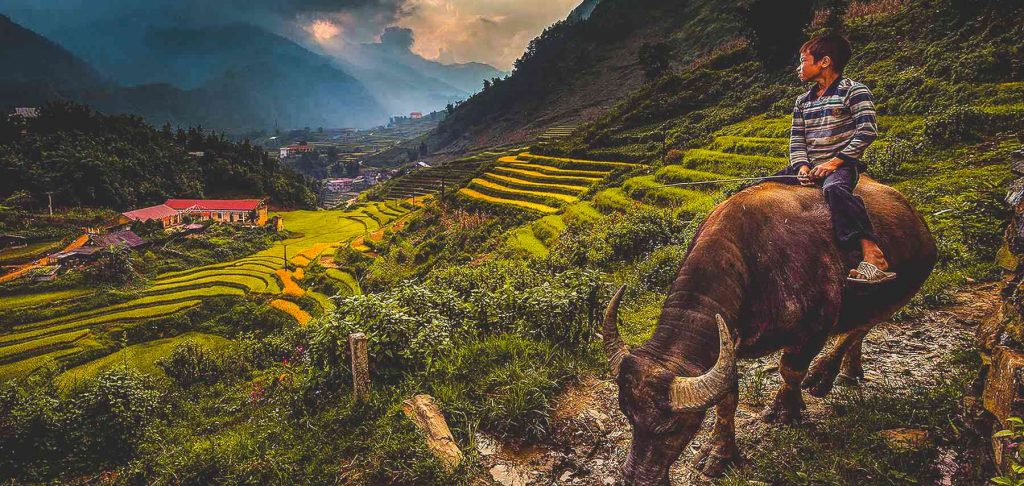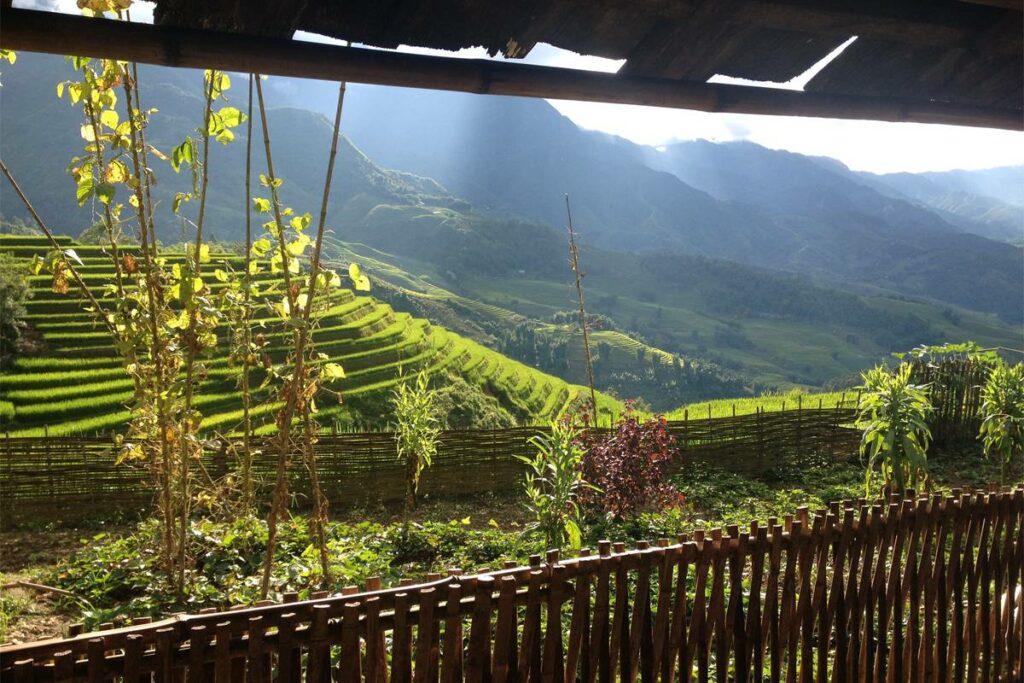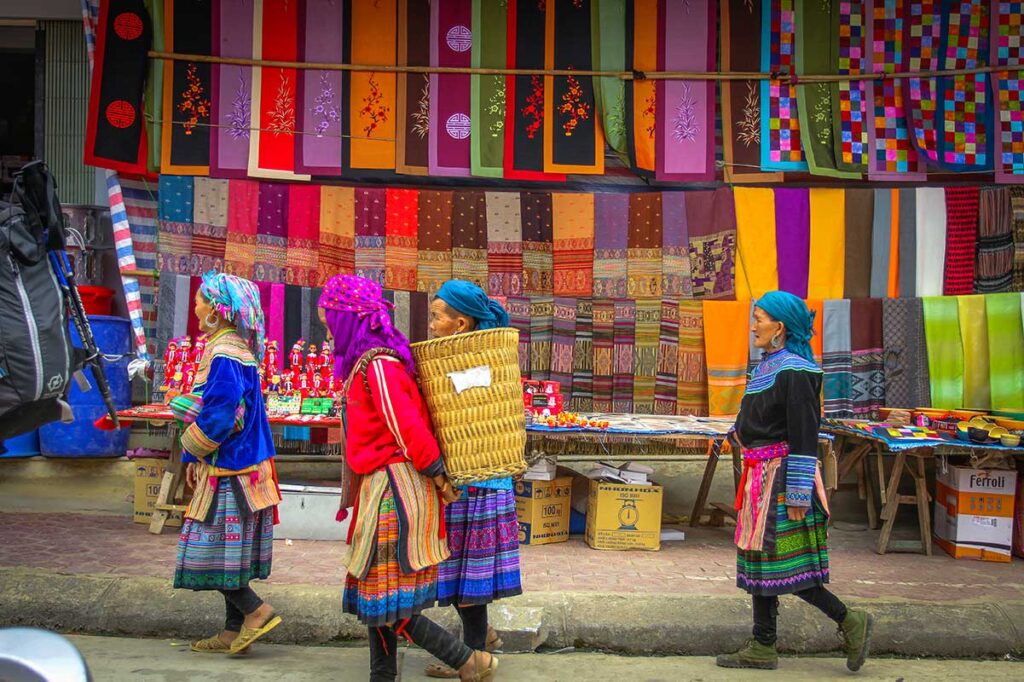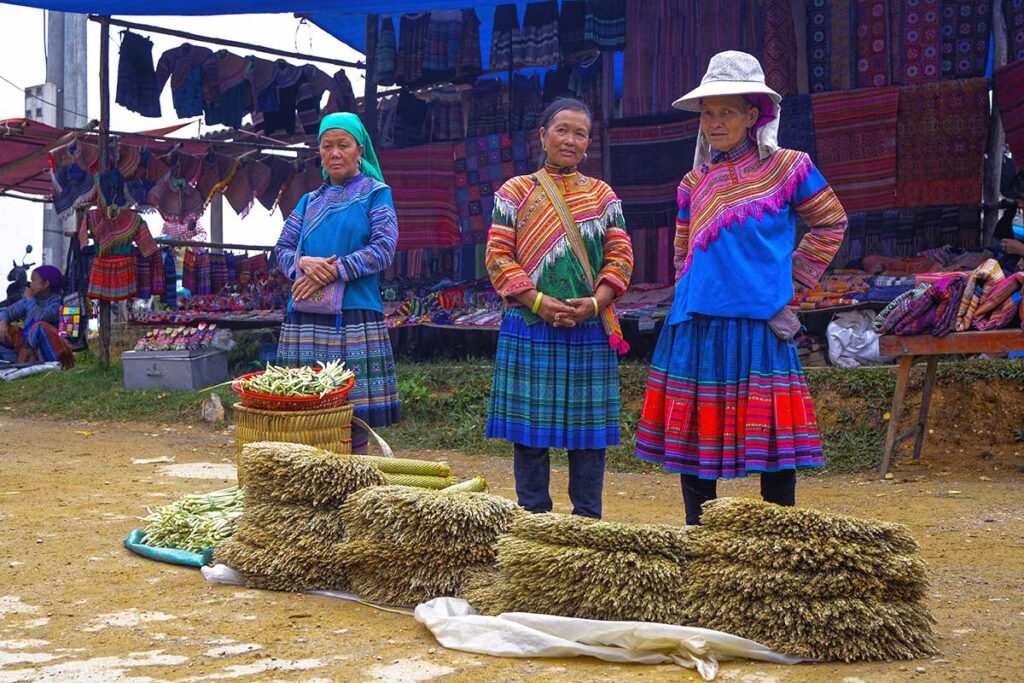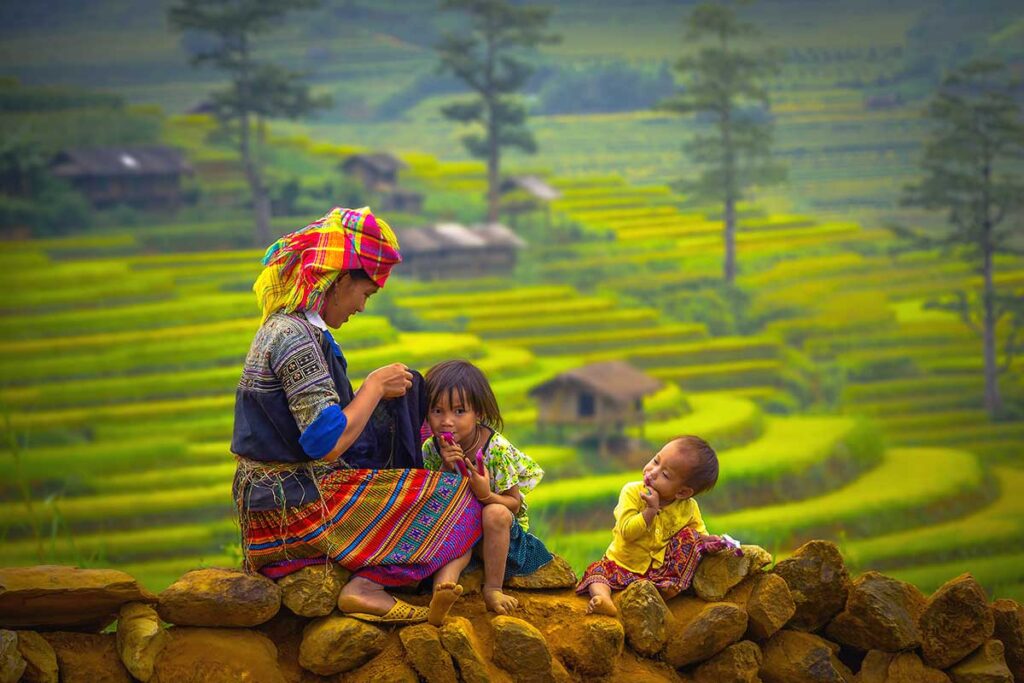Sapa: Home to iconic rice terraces and ethnic cultures
Once a quiet hill station established by the French, Sapa has grown into a busy travel hub surrounded by stunning mountain scenery. Despite its rapid development, it remains the gateway to one of Vietnam’s most iconic landscapes: the Muong Hoa Valley, where terraced rice fields cascade down the hillsides and ethnic minority villages are tucked between the slopes.
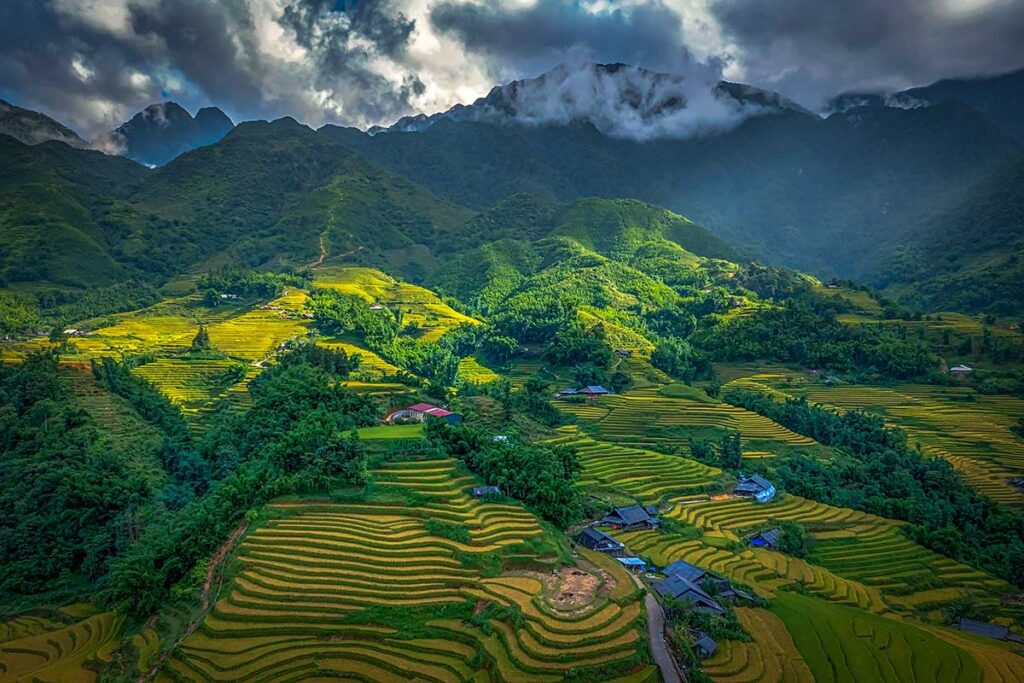
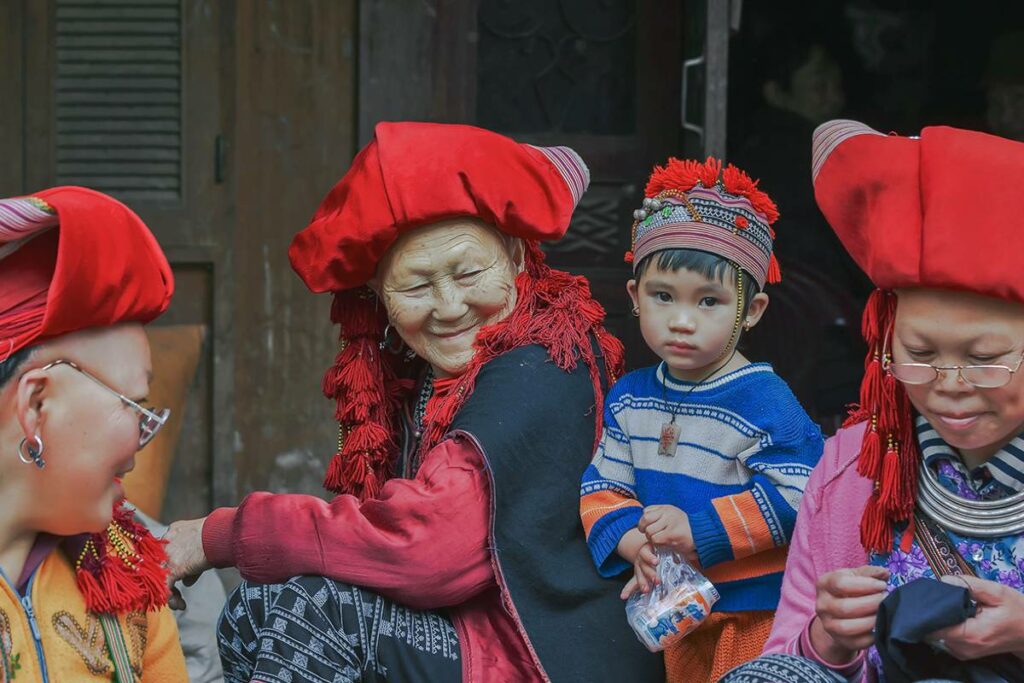
Sapa is known not only for its dramatic views, but also for the vibrant cultures of the Hmong, Red Dao, Tay, and Giay people who call this region home. You’ll see them in traditional dress in the town center, at the markets, or walking along the roads between villages. While the town itself can feel busy and touristy, the real charm lies in the countryside just beyond—whether you’re trekking, riding a motorbike, or staying in a local homestay.
This mix of landscapes and local life is what makes Sapa such a unique destination in Vietnam’s north.
Best things to do in Sapa
Sapa offers a wide range of activities that highlight both its natural beauty and rich cultural heritage. Below you’ll find the best things to do in Sapa, from scenic viewpoints to unique local experiences.
1. Trekking through Muong Hoa Valley
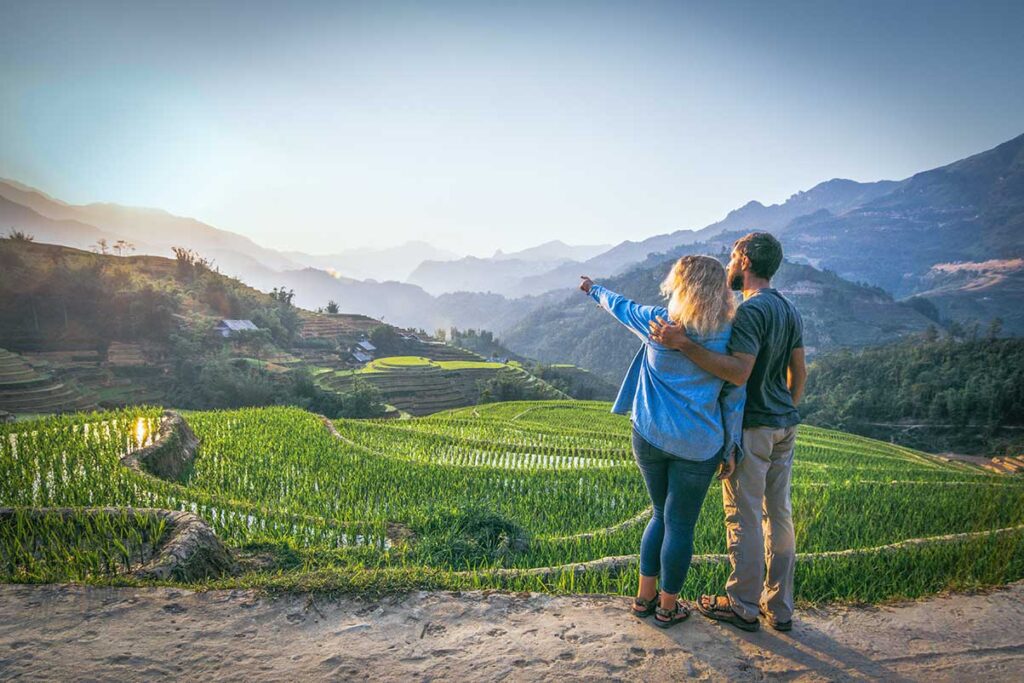
The number one reason travelers come to this region is for the stunning landscapes and unique hill tribe culture found in Muong Hoa Valley. That’s why the most popular activity—and arguably the best thing to do in Sapa—is a trekking tour. It’s the most immersive way to see terraced rice fields, bamboo forests, and ethnic minority villages up close.
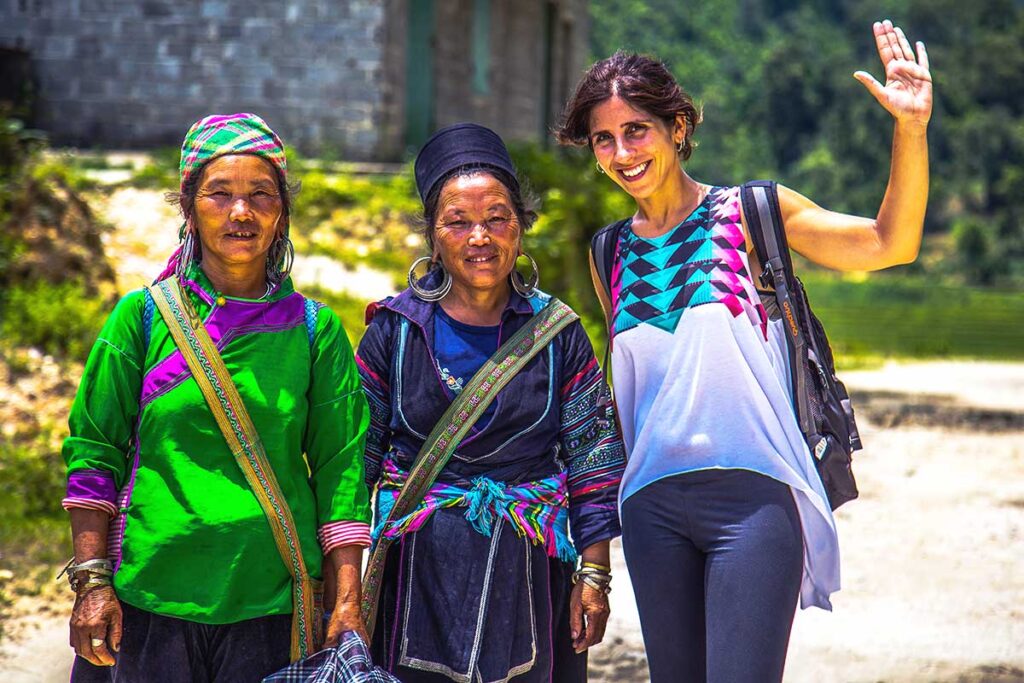
You don’t need to be an experienced hiker to enjoy it. Treks range from short half-day walks to multi-day adventures that take you well beyond the tourist areas. Some paths are easy and mostly flat, others take you off the beaten path over muddy trails and steep hills. Whether you want something light or more challenging, it’s easy to tailor your trek.
Read more about trekking in Sapa (routes, options, guided and self guided)
Tip: Take a car if you can’t hike
Not keen on hiking? No problem. A car can take you along the main road that runs through the valley, connecting villages and viewpoints. While smaller paths into remote villages aren’t accessible by car, you can still enjoy sweeping views and visit more local, less touristy areas. Great for half-day or full-day sightseeing.
Read more about renting a car in Sapa
2. Visit ethnic minority villages
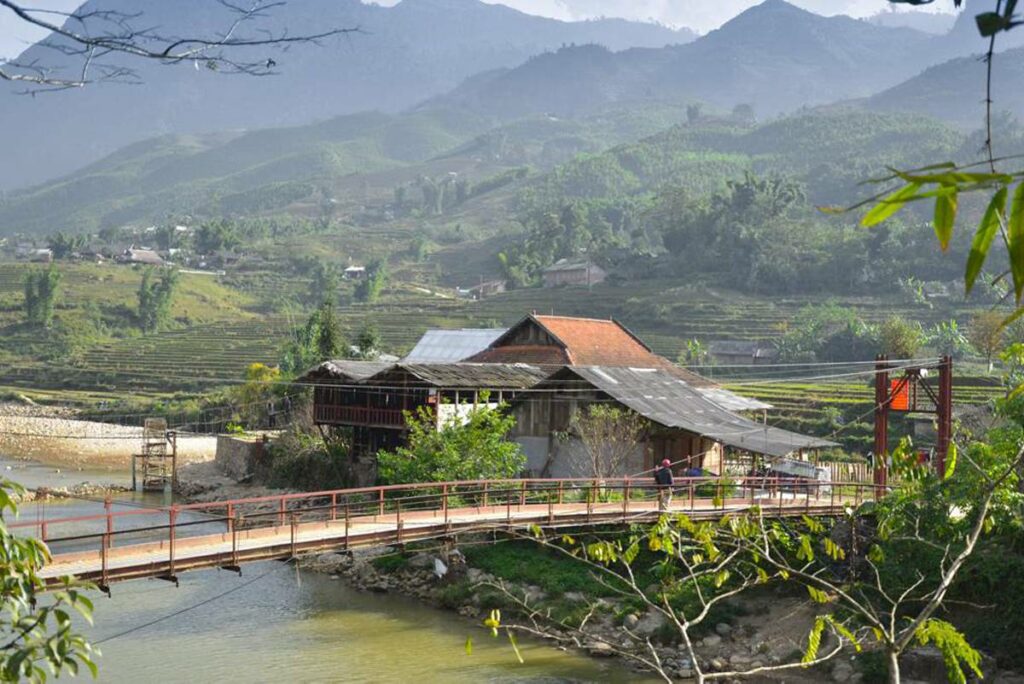
As striking as the rice fields are, what makes Sapa truly special is the ethnic diversity of its people. The surrounding mountains are home to groups like the Black Hmong, Red Dao, Giay, and Tay—each with their own language, clothing, and traditions.
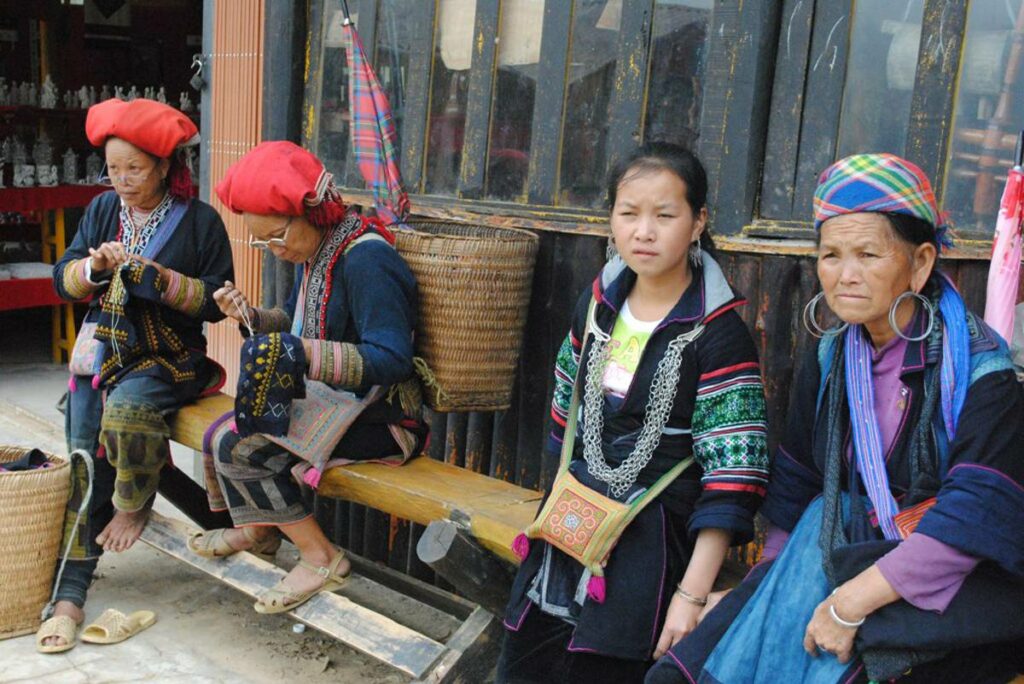
While you’ll see ethnic minorities in Sapa town, visiting their villages gives you a far more authentic view of daily life. Many treks pass through multiple villages, allowing you to witness how these communities live, farm, cook, and raise families in the highlands. Every village has its own atmosphere, and you might even notice differences between the groups as you go.
Pro Tip: Avoid Cat Cat Village if you’re looking for authenticity. It’s set up as a tourist attraction with staged activities and entrance fees. While photogenic, it lacks the real cultural experience you’ll find in less commercialized villages deeper in the valley.
3. Stay overnight in an ethnic homestay
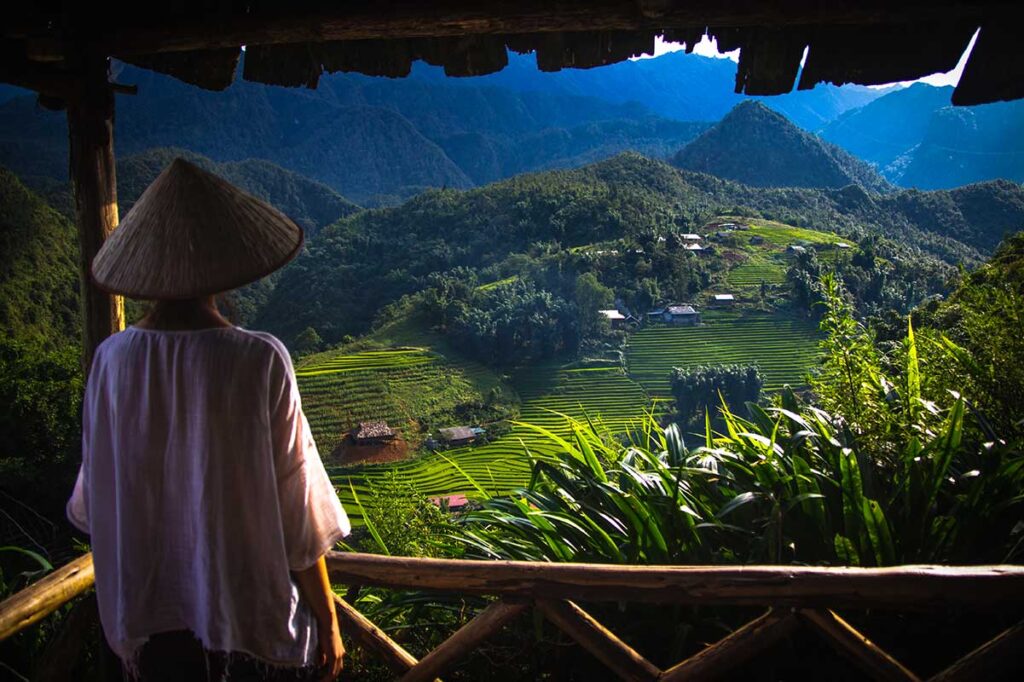
Spending the night in a homestay is one of the most memorable things to do in Sapa. These homes, often in small villages like Ta Van or Ban Ho, are run by local ethnic families and offer a true look into highland life.
Expect simplicity: wooden houses, hard mattresses, shared bathrooms—but with basic comforts like hot water and mosquito nets (now legally required). The real luxury is cultural: helping prepare dinner, sharing stories over homemade rice wine, and maybe even trying a traditional herbal bath (especially with the Red Dao people).
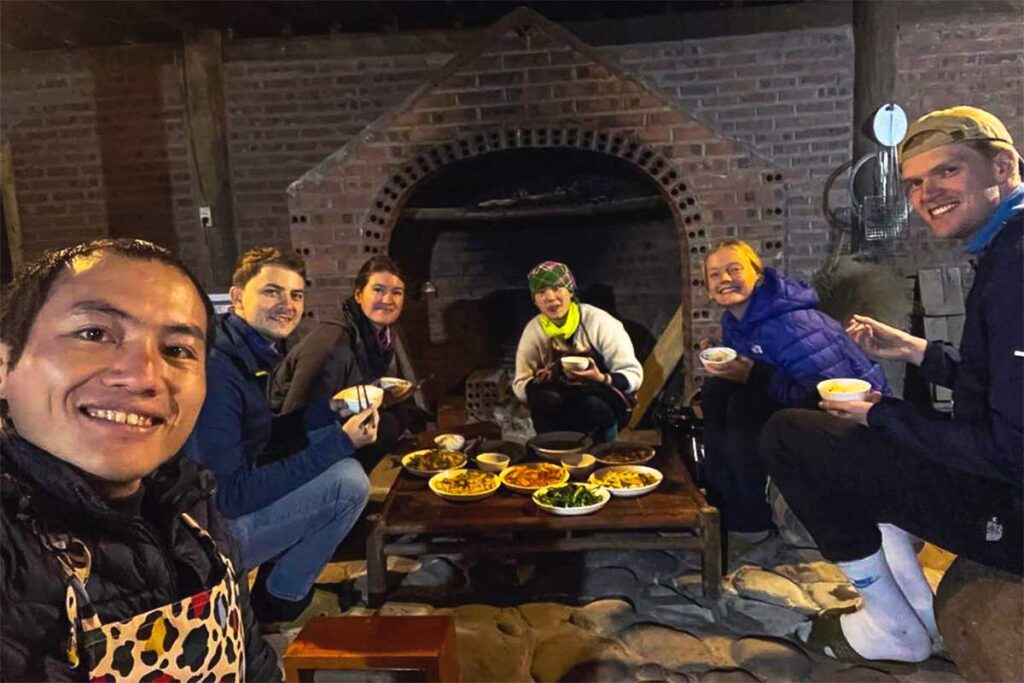
Just one night is enough to leave a lasting impression. You’ll gain a new perspective on life in the mountains—and likely leave with a few new friends.
Read more about homestays in Sapa
Tip: Not all homestays are ethnic-run. Some are modern guesthouses built by outsiders. While these still offer a more personal experience than a hotel, they don’t provide the same cultural connection as staying with a local minority family.
4. Take the Cable Car to Fansipan
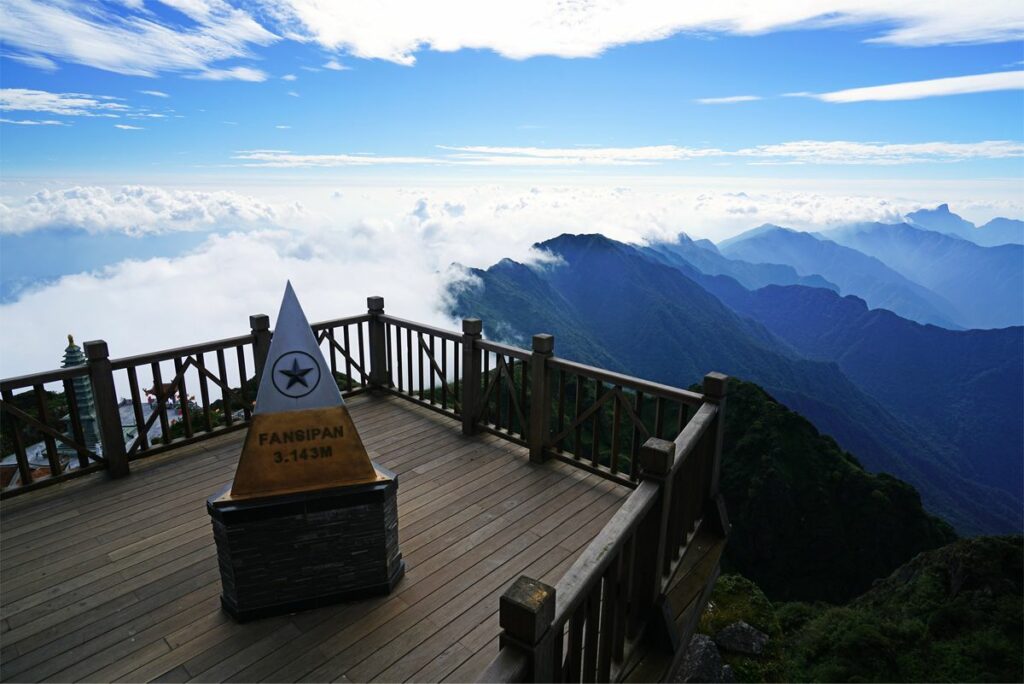
Fansipan is the highest mountain in Vietnam at 3,147 meters, often called the “Roof of Indochina.” While it used to take two to three days of intense climbing to reach the top, it’s now possible to get there comfortably within an hour.
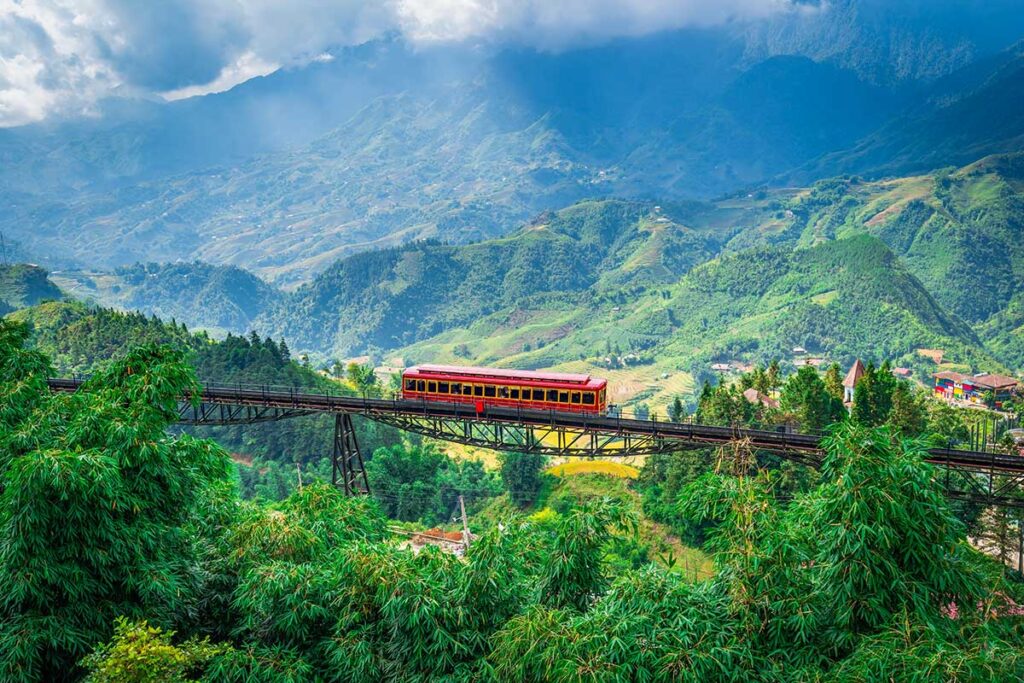
Your journey begins with a short scenic mountain train ride from Sapa town to the cable car station.
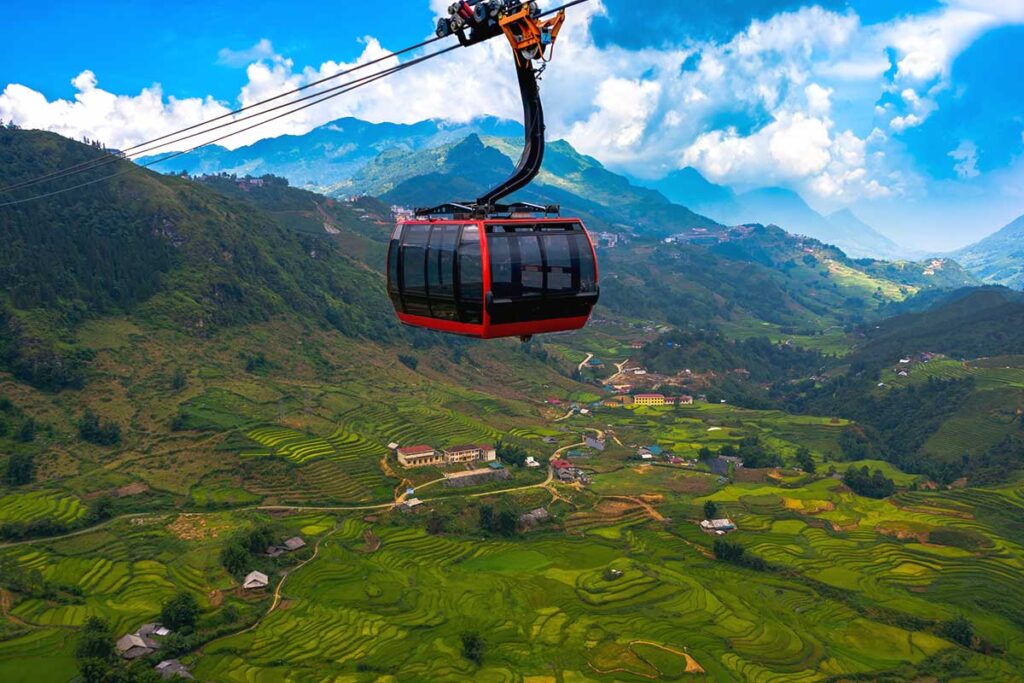
From there, a dramatic 15-minute cable car ride takes you high over valleys and thick forests to a complex near the summit. The final stretch can be done by stairs or a funicular train, depending on your energy level.
At the top, you’ll find a collection of newly built pagodas and monuments. On clear days, the panoramic views are absolutely breathtaking, stretching across northern Vietnam and even into China. But be aware: the peak is often covered in clouds, so check the forecast before planning your visit.
Read more about Fansipan and how to get there
5. Explore local minority markets
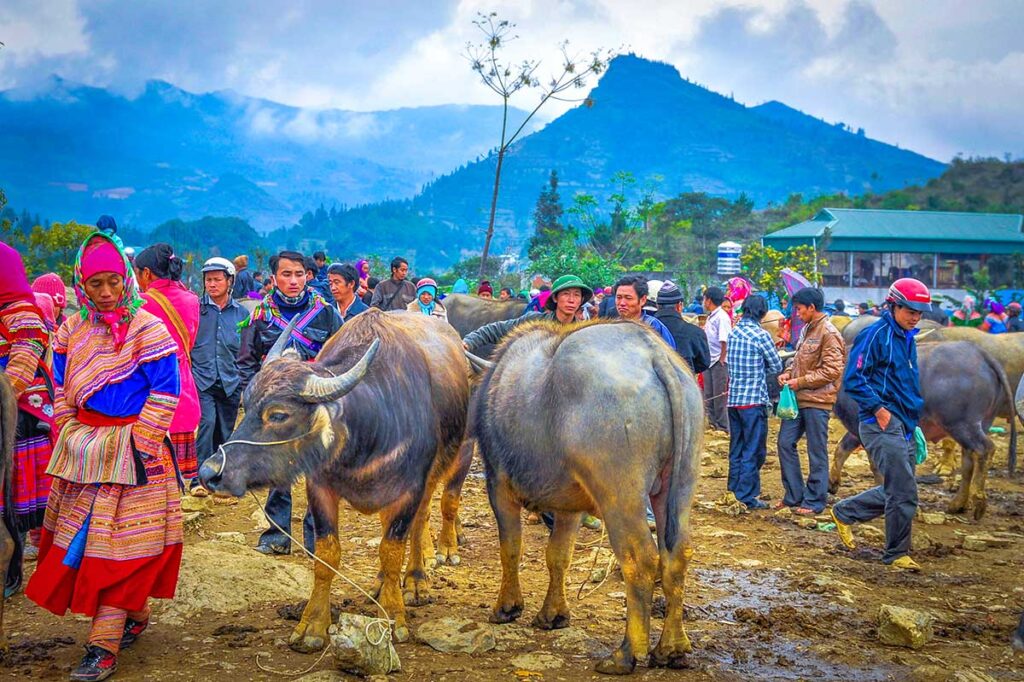
The area around Sapa is home to many ethnic groups, each with their own villages, language, and culture. A few bigger towns host weekly minority markets, where different ethnic groups from surrounding villages come together to buy and sell everything from clothing and vegetables to livestock like buffalo and pigs.
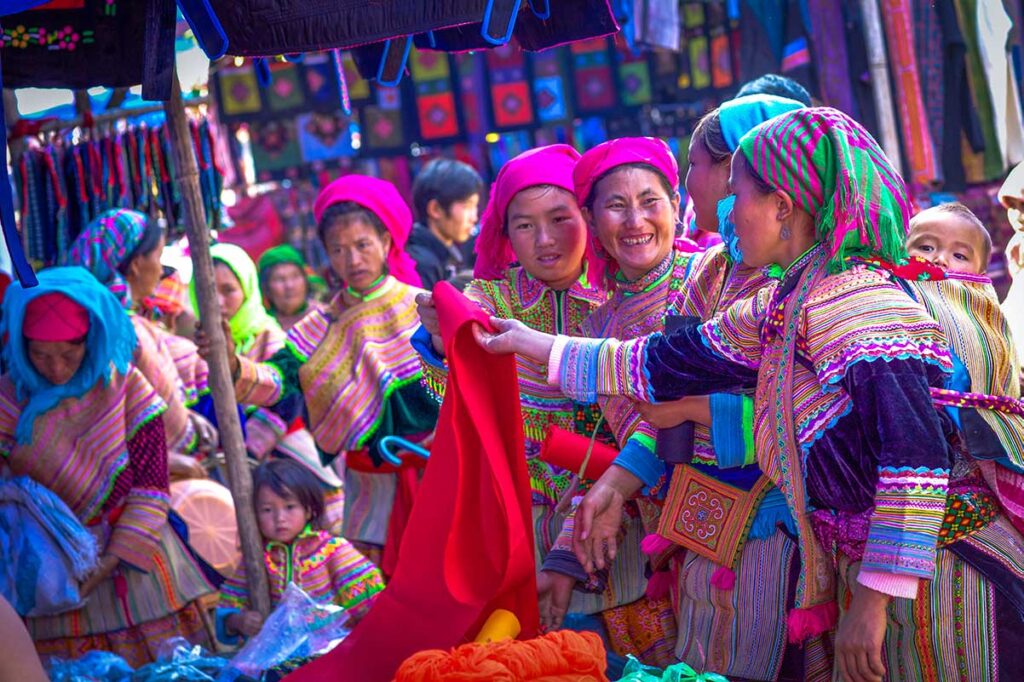
But markets aren’t just for shopping—they’re important social gatherings. Locals come to trade, eat, drink rice wine with friends, share gossip, and even get a haircut. The atmosphere is lively and colorful, with every ethnic group proudly wearing their traditional dress, creating a rich tapestry of sights and sounds.
Some of the most well-known markets around Sapa include:
- Bac Ha Market (Sunday)
- Can Cau Market (Saturday)
- Coc Ly Market (Tuesday)
These markets are located outside Sapa and are often best reached by car or as part of a guided tour.
See the full guide to markets around Sapa
6. Enjoy the view from Tram Ton Pass
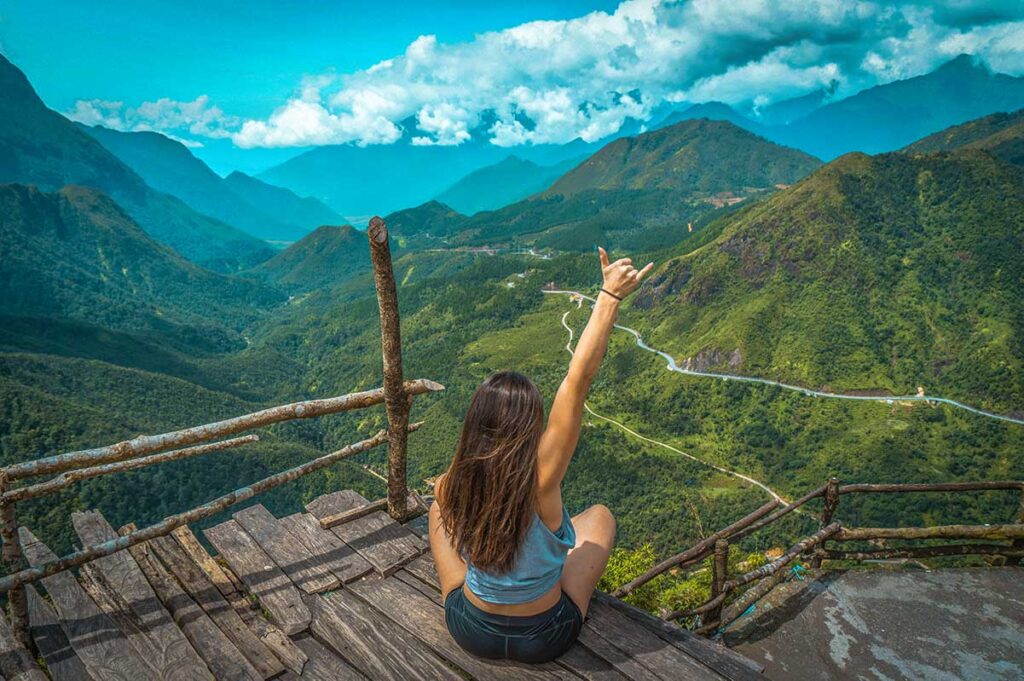
The Tram Ton Pass, also known as O Quy Ho Pass, is the highest mountain pass in Vietnam and connects Sapa with the Lai Chau province. It’s one of the most scenic drives in the north, cutting through high mountains with sweeping views of the valleys below.
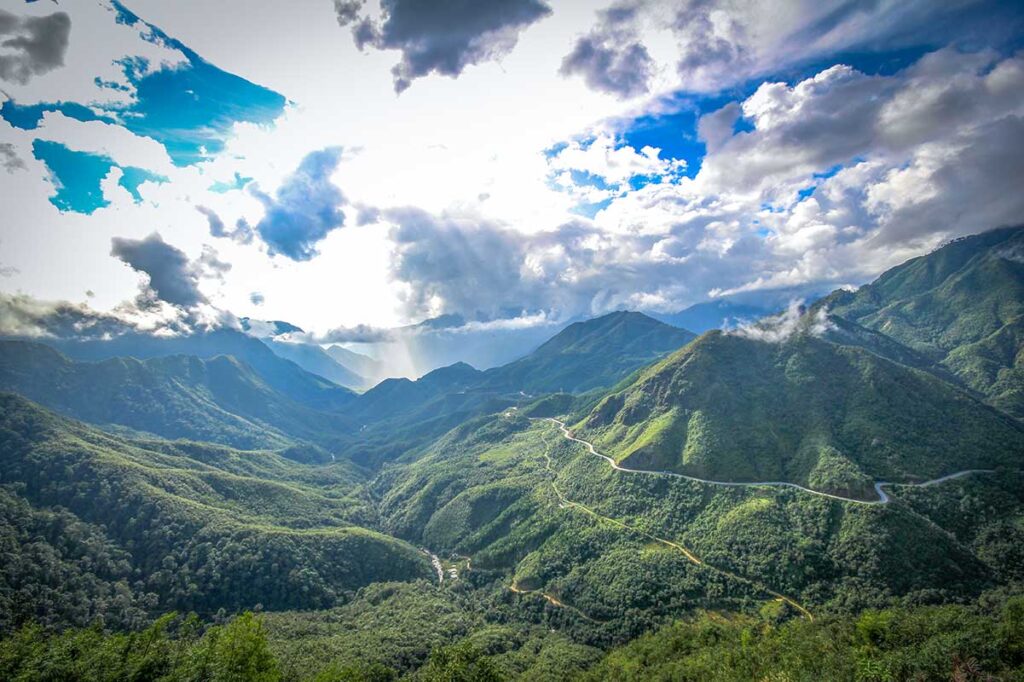
For travelers, the main viewpoint at the top of the pass is a must-visit. You can reach it by car or motorbike—ideally on a clear day for the best visibility. There are also small coffee shops where you can relax and enjoy the view, some with photo spots and local-style decorations.
Read more about Tram Ton Pass
Tip: Just nearby is the Glass Bridge, a tourist attraction with dramatic cliffside views. It features not only the glass-bottomed walkway but also a zipline, skywalk, and other adventurous activities.
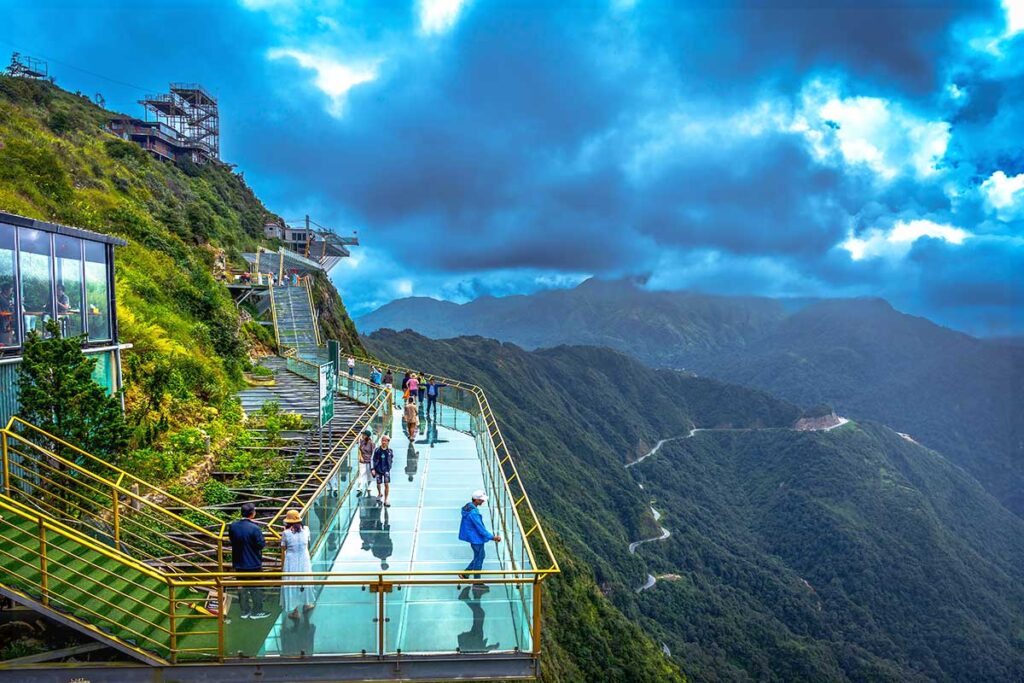
While it’s a bit kitschy, it can still be fun for those looking for something different.
Read more about the Sapa’s Glass Bridge
7. Visit Love Waterfall and Silver Waterfall
Both Love Waterfall and Silver Waterfall are located along the scenic Tram Ton Pass road, making them an easy addition to a half-day trip from Sapa.
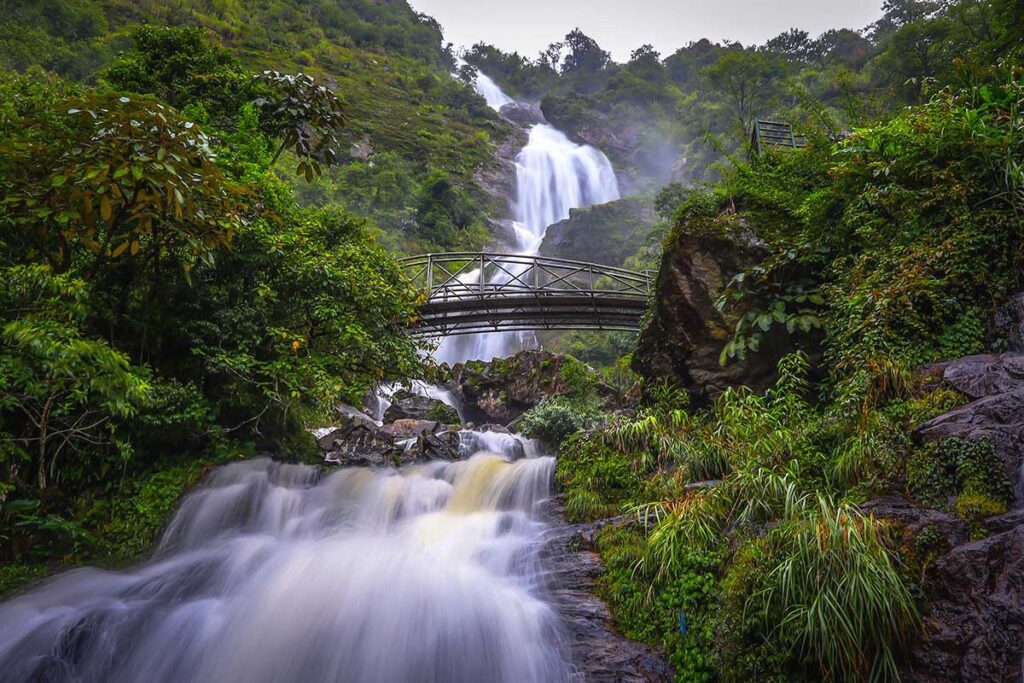
Silver Waterfall is the more accessible of the two, located right next to the main road. You can view it within minutes of arrival, making it a quick and convenient stop. However, it’s also more developed and frequently visited.
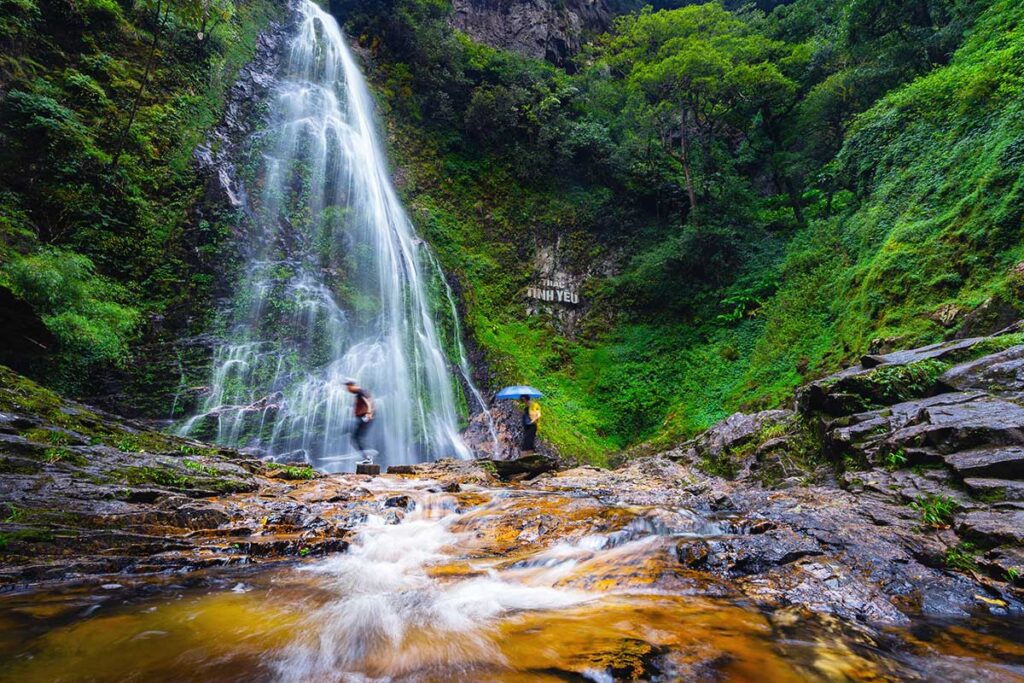
Love Waterfall, on the other hand, requires a 30-minute hike through pine forest and peaceful streams. The trail itself is already a highlight, and because many travelers skip the walk, you often get the waterfall almost to yourself. It’s quieter, more scenic, and definitely worth the effort.
In addition to these, there are several other waterfalls around Sapa. Some are seasonal and may dry up during the dry months, while others flow year-round. See our full guide to the best waterfalls in Sapa
8. See the Sapa tea hills during blossom season
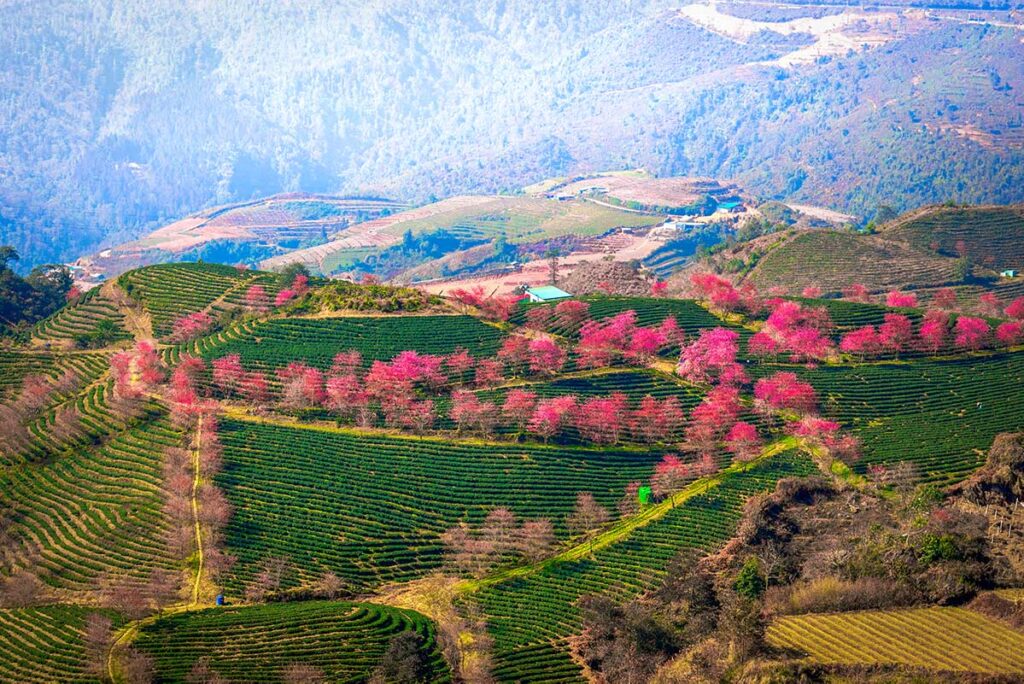
Just outside Sapa, on the way to Tram Ton Pass, you’ll find the rolling green hills of O Long Tea Hill, one of the most photogenic landscapes in the region. What makes this place truly special is the annual cherry blossom season, when thousands of pink-white trees bloom across the tea-covered slopes.
The best time to visit the tea hills during blossom season is late December to early February, depending on the weather. This short window transforms the area into a painterly landscape—ideal for photography and quiet walks.
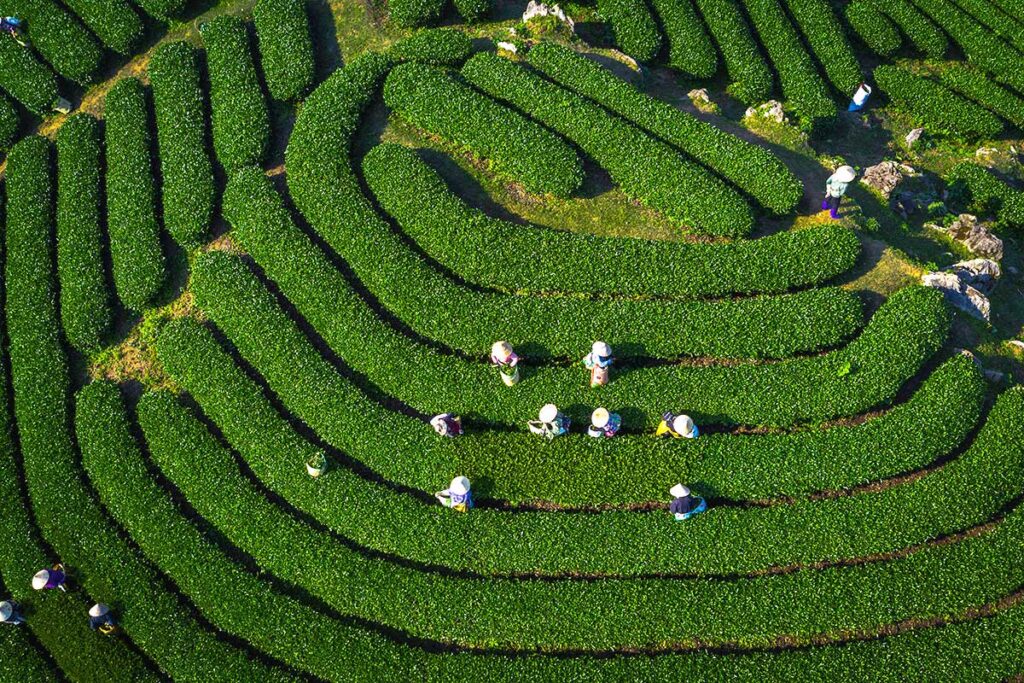
Even outside the blossom season, the tea hills are still worth visiting for their peaceful scenery and panoramic views. You can walk along the terraces, enjoy the cool highland breeze, and see tea workers harvesting leaves by hand.
Read more about Sapa’s O Long Tea Hill and blossom season
9. Join a motorbike tour around remote parts of Sapa
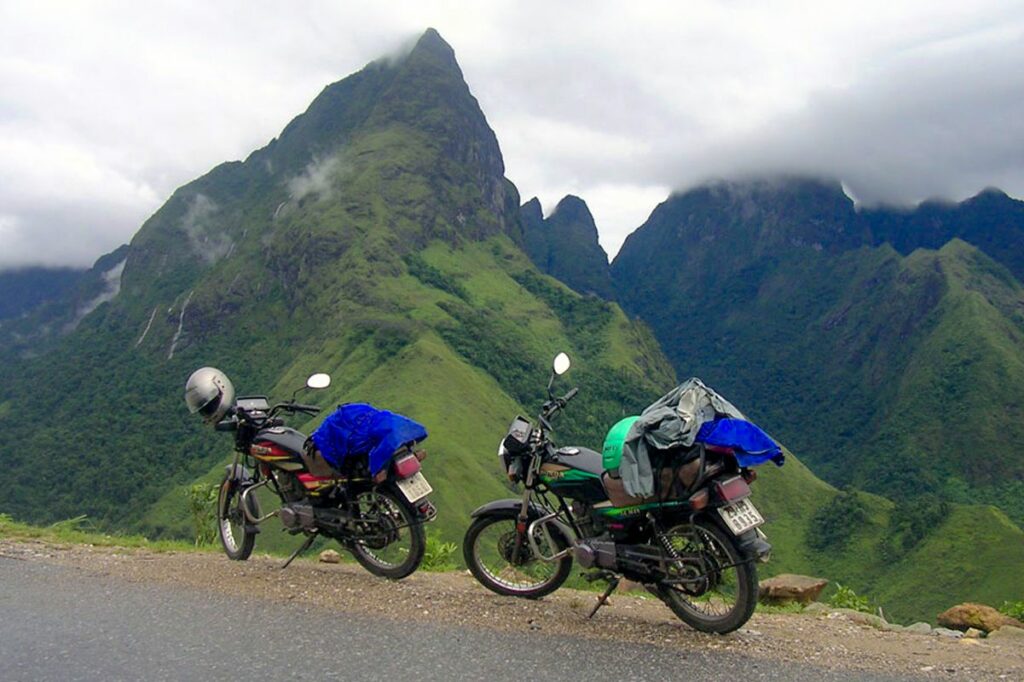
One of the most exciting things to do in Sapa—especially if you’re looking for adventure—is to explore the remote areas around town by motorbike. It’s a great way to get off the beaten track, especially if you’ve already seen the popular spots.
You have two options: self-driving, which is only recommended if you’re highly experienced and hold a valid international motorbike license, or riding on the back with a local guide—a much safer and more relaxing alternative.
Motorbike tours take you beyond the Muong Hoa Valley to more untouched regions with dramatic scenery, ethnic villages less influenced by tourism, and stunning viewpoints you wouldn’t reach by car. It’s a raw and authentic experience, ideal for travelers who want to see Sapa beyond the standard routes.
Explore our motorbike tours in Sapa
10. Walk Around Sapa Town
While Sapa town has grown rapidly and lost some of its original charm, a walk through the center can still be worthwhile—especially if you have some time between treks or activities.
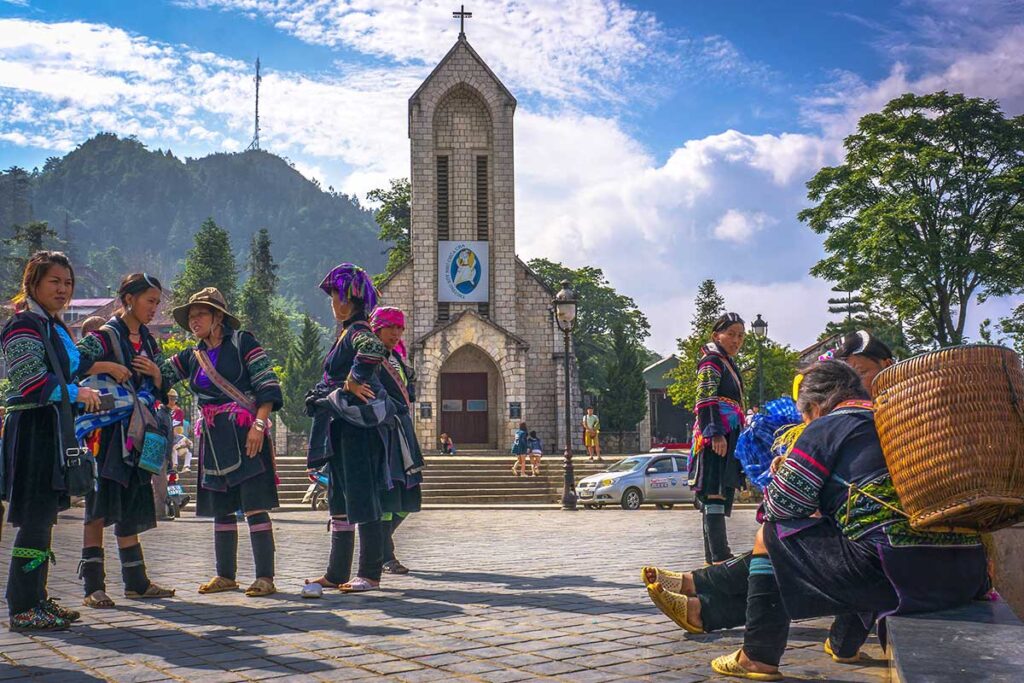
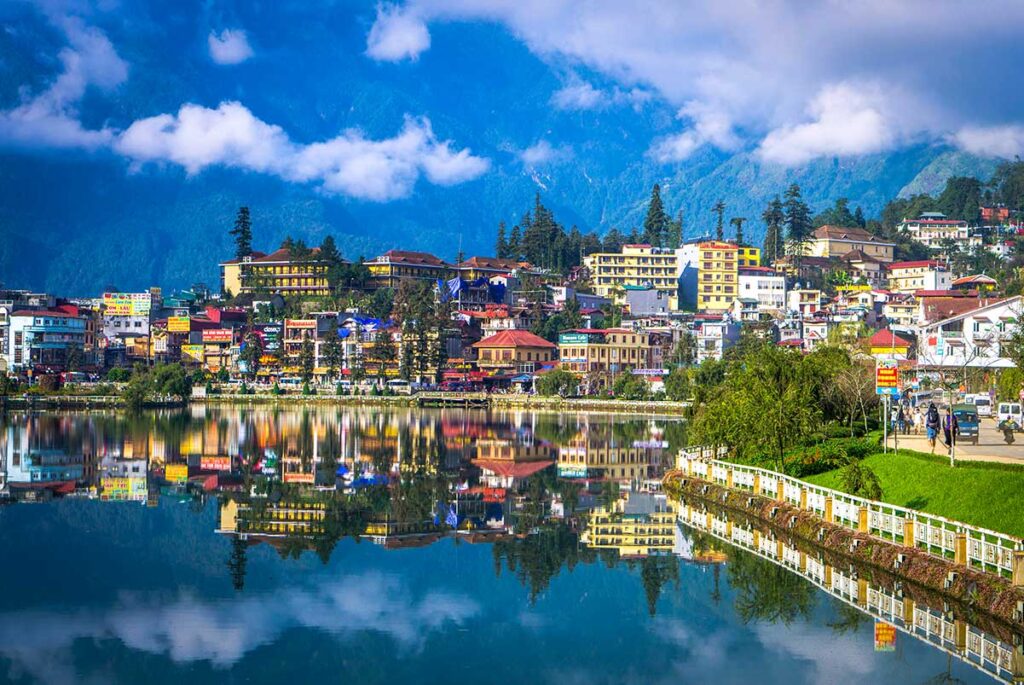
Key places to see include the central lake, which offers a peaceful loop with benches and mountain views, and the Sapa Stone Church, a historic French colonial landmark still in use today. You’ll also find a small local museum with exhibits on ethnic minority cultures, and the central market, which is liveliest on weekends when minority groups visit town.

If you’re up for a short climb, Ham Rong Mountain rises behind the town and has walking paths, gardens, and viewpoints overlooking Sapa and the surrounding valleys.
11. Relax in a Herbal Bath or Spa
After a long day of trekking or during rainy weather, one of the most relaxing things to do in Sapa is soaking in a herbal bath or visiting a local spa.
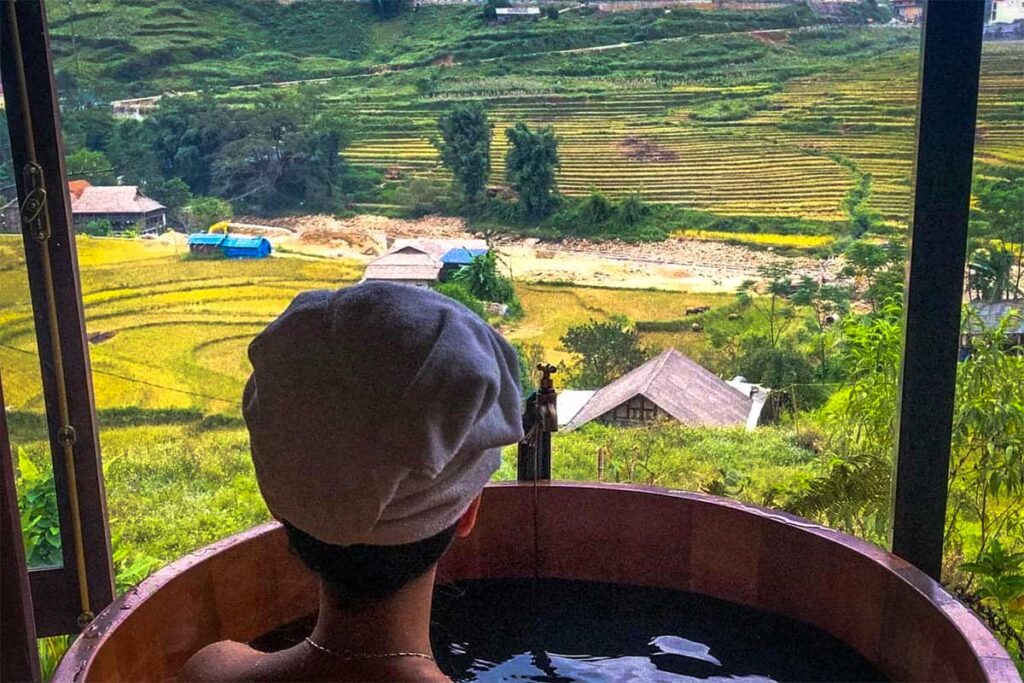
In Sapa town, you’ll find a number of modern spas offering hot stone massages, facials, and steam rooms—perfect for unwinding. But for something more authentic, head to one of the villages outside town where the Red Dao ethnic group offers traditional herbal baths. These are prepared with dozens of foraged forest herbs, heated in wooden barrels, and believed to aid blood circulation and muscle recovery.
Whether you choose the comfort of a spa or the authenticity of a Red Dao bath, both are great ways to relax and recharge during your stay.
12. Book a Room with a View
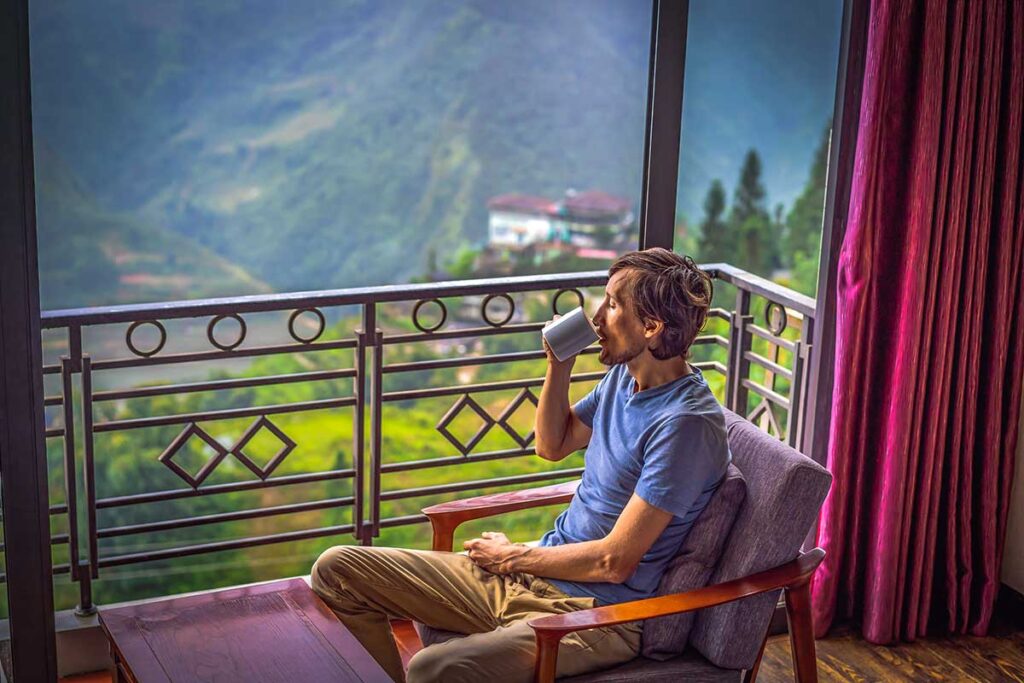
Not all the best things to do in Sapa involve activities—sometimes the most memorable experience is simply enjoying the view.
Skip the center of town and look for accommodation along Muong Hoa Road, especially just outside town where the rice terraces begin. Here you’ll find a mix of mid-range hotels and upscale lodges or resorts, many offering panoramic views of the rice fields and surrounding valleys. Some even come with infinity pools or bathtubs overlooking the mountains.
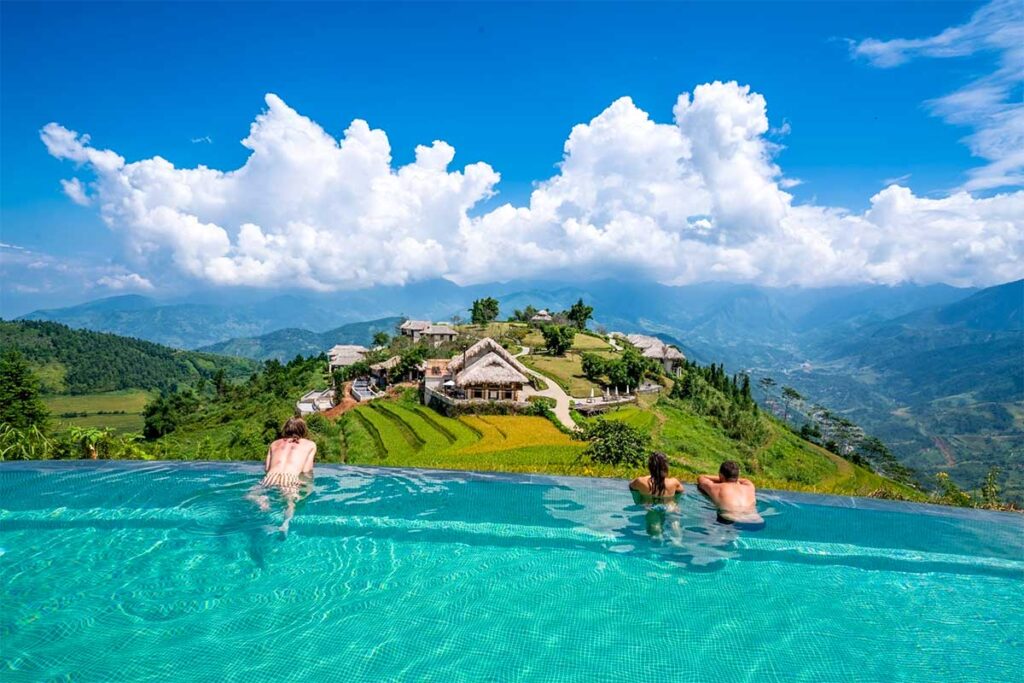
Whether you’re on a mid-level budget or looking for something more luxurious, waking up to this scenery is one of the highlights of visiting Sapa.
Tips:
- See our guide to Sapa hotels with a view
- Or explore Sapa’s best lodges and resorts with mountain views
Best time to visit Sapa
The best time to visit Sapa depends on what you’re coming for—weather or scenery. While spring and autumn have the most pleasant climate, the famous rice terraces only reach their full beauty at very specific times of year. Here’s a breakdown to help you choose the right timing for your trip.
Best weather in Sapa: March to May & September to November
Spring (March–May) and autumn (September–November) are ideal for outdoor activities. Expect cooler temperatures, clearer skies, and less rainfall—perfect for trekking, motorbike tours, and sightseeing. Spring brings blooming wildflowers, while autumn starts with golden rice fields and ends with crisp, dry days.
Best rice field scenery: Late April to early September
Sapa’s rice season follows a unique mountain rhythm.
- Late April to May: Fields are flooded, creating stunning mirror-like reflections.
- June to August: The terraces turn a deep, lush green as the rice grows.
- Late August to early September: This is harvest time—the most impressive period when the fields glow golden yellow.
After the harvest in mid-September, the terraces are cleared and scenery changes quickly.
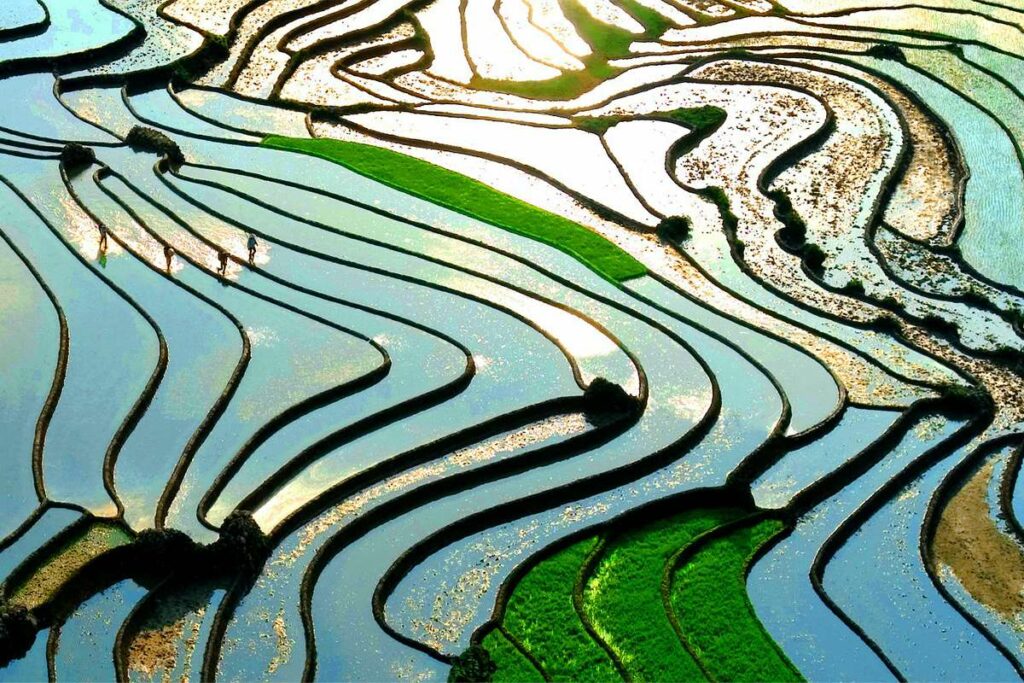

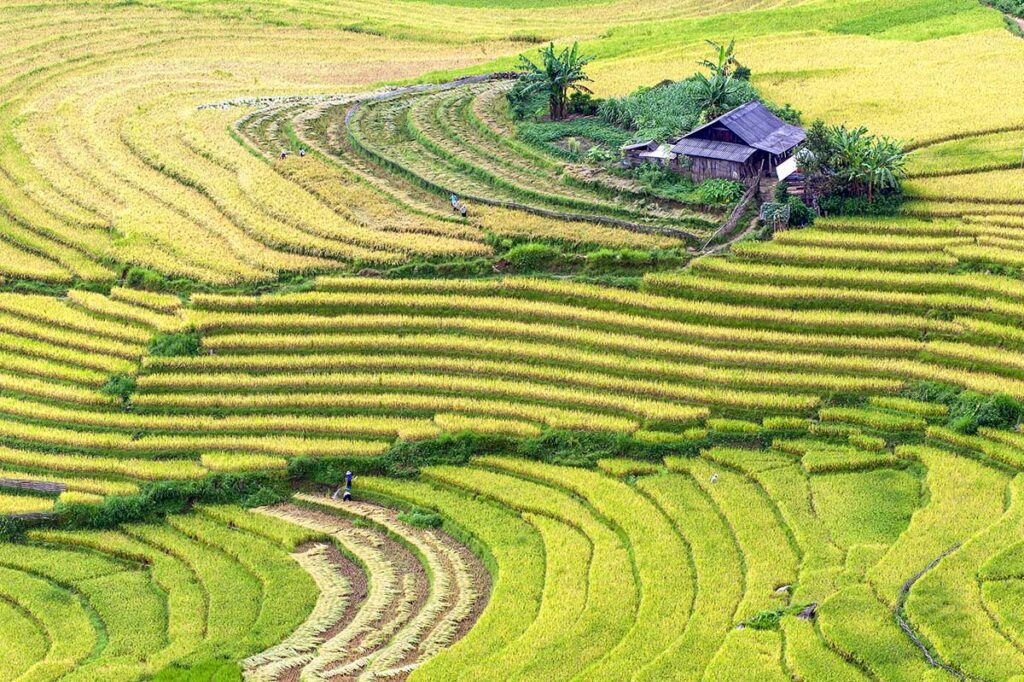
The overall best month: September
If you want the best mix of scenery and weather, September is your month. Early September is harvest time, with spectacular golden fields, and the weather is generally dry and mild. Just make sure to visit in the first half of the month, as harvesting may be finished by the end.
Sapa month-by-month overview
Here’s a quick look at what to expect each month:
- January – Cold and foggy. No rice fields. Good for quiet village visits or herbal baths.
- February – Still winter. Clear mornings possible. Bare terraces.
- March – Start of spring. Comfortable temperatures. No rice, but wildflowers bloom.
- April – Warm days. End of month sees first flooded “mirror” terraces.
- May – Mirror fields and planting season. Great for trekking and early scenery.
- June – Lush green terraces. Rainy season begins. Humid but photogenic.
- July – Greenest month. Expect heavy rain and muddy trails.
- August – Rain continues, but rice fields begin turning yellow. Very scenic.
- September – Peak scenery early in the month. Dry, cool weather starts.
- October – Harvest is finished. Clear skies and cooler weather for trekking.
- November – Cold nights return. Clear air and peaceful trekking without rice fields.
- December – Very cold, with chances of frost at night. No rice fields. Good for cultural stays.
Best hotels & hostels in Sapa
Where to stay
Hotels in the Center of Sapa (not recommended)
The center of Sapa offers many accommodation options, ranging from very cheap to super luxury. Staying here provides easy access to numerous restaurants, shops, and attractions. You’ll be within walking distance of Ham Rong Mountain, the train station to Fansipan, and more.
Accommodation on Muong Hoa Road
Muong Hoa Road starts from Sapa town and extends deep into Muong Hoa Valley, offering stunning views of mountains and terraced rice fields. Accommodation along this road provides breathtaking scenery. You can choose to stay closer to Sapa town or in a quieter area further away. Due to the amazing views, accommodations on this road tend to be more expensive than those in the city and include hotels, lodges, retreats, and resorts.
Homestays in the Villages
For a more authentic experience, consider staying in the villages outside of Sapa. The town of Sapa has become quite (over)developed, but the real charm lies in the terraced rice fields and ethnic people. Villages mainly offer homestays, which come in different types. Basic family-run homestays provide a true authentic experience, though they lack modern comforts. Alternatively, there are more modernized homestays that retain local style but offer private rooms, bathrooms, air conditioning, and nice decorations. This option allows you to immerse yourself in the local culture while enjoying some comforts.
Best hotels & hostels in Sapa
Budget hotels & hostels
- Mountain View Hostel
- Go Sapa Hostel
- Sapa Capsule
Mid range hotel
- Sapa Elite Hotel
- Praha Hotel Sapa
- Sapa Diamond Hotel
- Sapa Eden Hotel
High end hotel & resort
- Sapa Legend Hotel & Spa
- Sapa Freesia Hotel
- Pao’s Sapa Leisure Hotel
Food & drinking
Restaurants
There are many restaurant in Sapa, including both local dishes as western dishes as pizza, pasta and hamburgers. Try the specialities of the local hill tribes, often with wild mushrooms, herbs and local fish.
- Good Morning Vietnam Restaurant
- Sapa Natureview
- Little Vietnam Restaurant
- Moment Romantic Restaurant
- Good Morning View Restaurant
- Hill Station Signature Restaurant
Nightlife
Sapa is not known for its hectic nightlife. There are a few bars that offer a place to meet fellow travelers, drink a few beers and play a game of pool. Most restaurants that sell beer and other beverages tend to close early in the evening.
- Mountain Bar & Pub: Cocktails, cold beer and games, this is the to-go bar for an evening out.
- Hmong Sisters: A spacious bar with pool tables and a fireplace with great music.
Read our full guide about: Sapa at night.
How to get there
Sapa does not have a airport, but there are direct buses from Hanoi and there is a train station not too far from Sapa town.
Hassle-free travel from Hanoi to Sapa
Skip the stress of arranging transport. Our Sapa tours include all transfers from Hanoi—by bus or train—plus a mix of trekking, local markets, and scenic car tours.
Buses to Sapa
The bus from Hanoi to Sapa is the cheapest option. The advantage of a bus connection is that it goes directly to the city of Sapa, without stopping anywhere. You have both day time buses as well as night time buses to safe daytime. The bus trip from Hanoi to Sapa takes around 5 to 6 hours.
Read here everything you need to know about traveling by bus from Hanoi to Sapa.
Trains to Sapa
Many people who travel to Sapa choose the train because it is safe, comfortable, convenient and time-saving. The disadvantage is that the train only takes you to Lao Cai station, from there you have to take a bus, minibus or taxi to Sapa.
Read here everything you need to know bout the train from Hanoi to Sapa.
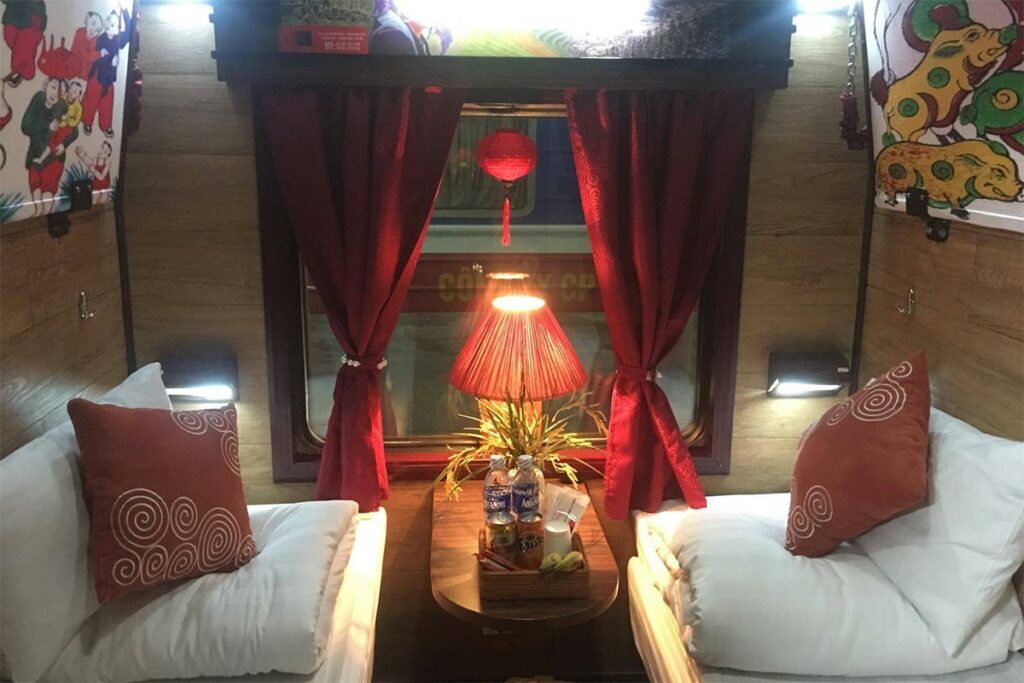
How to get around
Hiking – Places in the city of Sapa are easily reached on foot, because Sapa is small enough. Hiking is also the best way to explore the area around Sapa. However, if you choose this form of travel, you must also provide yourself with good shoes, drinking water and good endurance. There are a few small day walks that you can do alone. It is recommended to do a multi-day trek through the area with a guide who can show you the way.
Cab – The price for a taxi in Sapa is almost the same as in Hanoi. You can often choose between taxis with 5 to 8 seats, depending on the number of people you are with. Some reliable taxi companies are: Sapa Green Taxi, Phan-xi-pang taxi, Northwest taxi. You pay per kilometer from 9,000 to 12,000.
Motorbike – You can rent a motorbike in Sapa from 100,000 VND a day. Keep in mind that driving through the mountains of north Vietnam is not without danger and only meant for people with experience. An alternative is to go on the back of a motorbike with an experienced guide.
Per tour – A comfortable way of traveling in Sapa is per tour. No danger of driving a motorcycle on difficult roads and no stress of getting lost. A simple way to view the highlights and a local guide who can show you things about the area and tell them.
Itinerary 2 days in Sapa
With just two days in Sapa, you can still experience the region’s most iconic highlights—terraced rice fields, ethnic villages, and panoramic mountain views. Here’s a simple but well-balanced itinerary:
Day 1
- Start your trip with a guided trekking tour through the Muong Hoa Valley, one of the best things to do in Sapa. The trail takes you through terraced rice fields and ethnic minority villages such as Lao Chai, Ta Van, or Y Linh Ho.
- Spend the night in a local homestay, where you’ll share a traditional family dinner and gain insight into hill tribe life.
Day 2
After breakfast, your trek ends in the late morning or early afternoon.
From here, choose how you want to end your Sapa trip:
- Take the cable car to Fansipan, the highest mountain in Vietnam, for sweeping views and pagodas near the summit.
- Or head to Tram Ton Pass by private driver or motorbike for panoramic viewpoints, cool mountain air, and stops at Silver and Love Waterfalls.
Tips for traveling to Sapa
Whether you’re planning a short getaway or a longer stay, these practical tips will help you prepare for your trip and make the most of your time in Sapa. From planning your itinerary to packing smart and traveling responsibly, here’s everything you need to know.
How many days to stay in Sapa
It’s best to stay 2 to 4 days in Sapa, depending on how much you want to see and do. If you want to enjoy a variety of the best things to do in Sapa—such as trekking, visiting a local market, and exploring Fansipan and Tram Ton Pass—a minimum of 3 days is highly recommended. This gives you enough time to experience the highlights without rushing.
Where to go after Sapa
Many travelers combine Sapa with other scenic destinations in northern Vietnam. To visit Halong Bay or Ninh Binh, you’ll first always need to return to Hanoi, because all trains and buses run through Hanoi (no shortcuts).
However, there are direct connections to Ha Giang, known for its dramatic mountains, and Mu Cang Chai, famous for its terraced rice fields. If your focus is trekking or rice field scenery, it’s often best to choose between Sapa and Mu Cang Chai rather than trying to do both.
Traveling with kids
Sapa is a great place for children, especially if you tailor activities to their age and energy levels. You can choose short, easy treks, explore local villages, or ride the cable car to Fansipan. It’s also a unique cultural learning opportunity. For more ideas, see our full guide on what to do with kids in Sapa.
Sapa when raining
Even in rainy weather, Sapa can still be enjoyed. The Muong Hoa Valley has cozy cafés with sweeping views, and many hotels offer similar views right from your room. If you prefer to get out, consider a scenic drive by car. For a full list of rainy day activities, check our guide to things to do in Sapa when it rains.
Language and communication
In Sapa town, many people working in hotels and restaurants speak a fair amount of English. However, in remote ethnic minority villages, communication can be more difficult. If you’re planning a homestay or a cultural visit, going with a local guide is the best way to bridge the language gap and learn more.
Money and ATMs
There are several ATMs in Sapa town, and many hotels and travel agencies accept and exchange Euros or US dollars. Card payment is common in town, but outside of it—especially in villages—it’s best to carry cash.
What to pack for Sapa
Pack according to the season. Bring warm clothes in winter, and light, breathable clothing with a raincoat for summer. Sunscreen and a hat are useful year-round. For trekking, a comfortable daypack and good walking shoes are essential. You don’t need heavy trekking boots—opt for lightweight shoes if Sapa is your only trekking stop during your Vietnam trip. See our trekking packing list for more details.
Internet and connectivity
Wi-Fi is widely available in hotels, cafes, and homestays in Sapa town. In remote areas, the connection may be weak or unavailable. Consider buying a local SIM card with mobile data for better coverage, especially if you plan to go off the beaten path.
Road conditions and travel time
While roads in and around Sapa town are in good condition, travel to surrounding villages can be slow due to winding mountain roads. Distances may look short on a map but can take much longer to drive. Always allow extra time, and note that rain or fog may affect road conditions.
Responsible travel tips
Respect the culture and privacy of local communities. Always ask before taking close-up photos, especially in villages. Avoid giving money or candy to children—this can cause dependency and affect their education. Instead, support community-run projects or buy local products to give back in a meaningful way.
